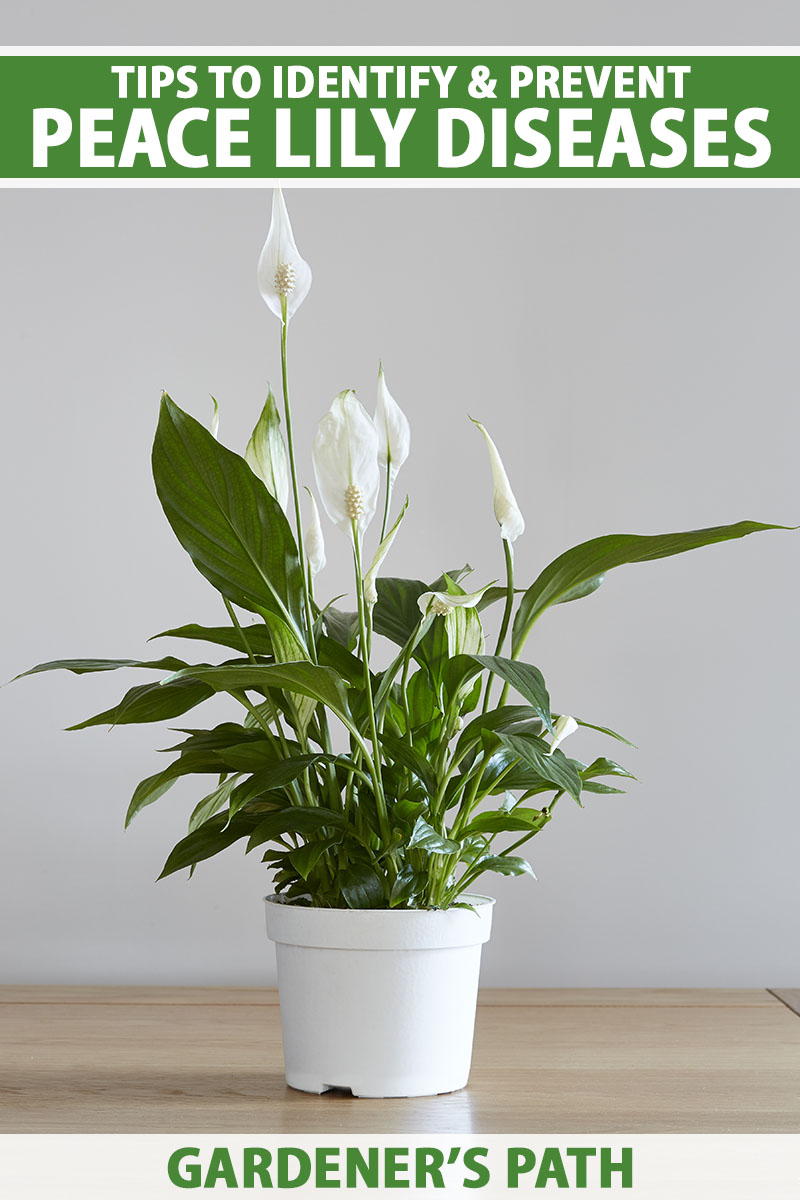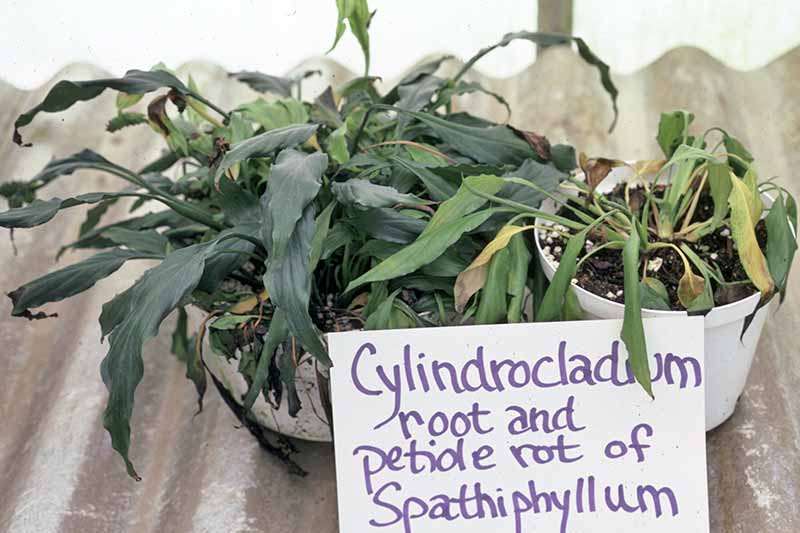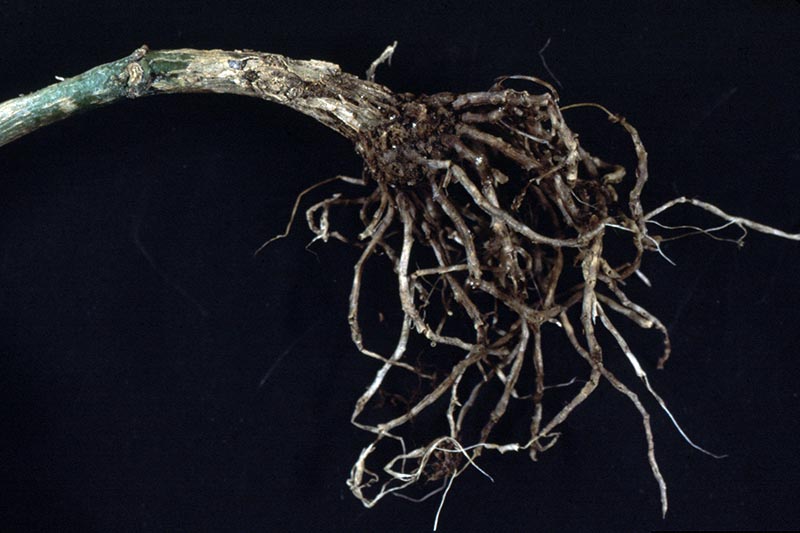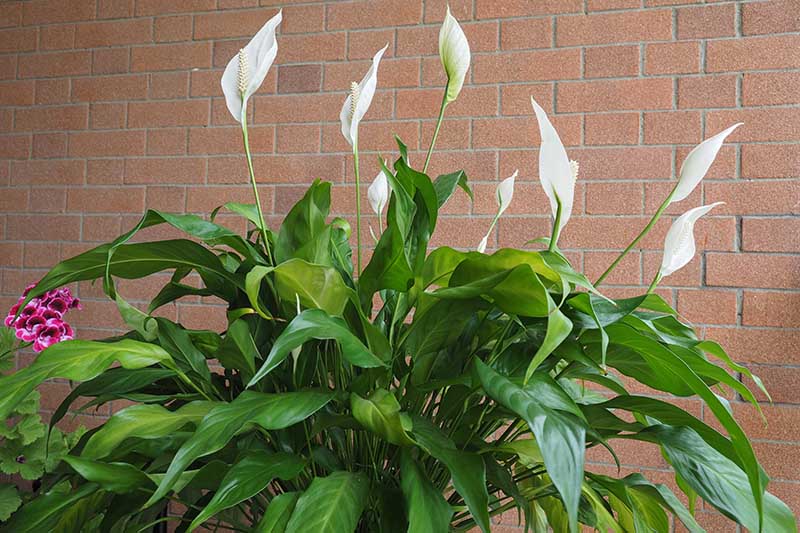Peace lilies, Spathiphyllum spp. are easygoing houseplants that seldom suffer from disease issues when provided with the right care.
In fact, they are so easy to grow that Dr. Leonard Parry, Horticulture Professor at the University of Vermont says that they have been called the “perfect houseplant.”
In our guide to growing peace lilies, we cover how to cultivate these popular plants indoors.

We link to vendors to help you find relevant products. If you buy from one of our links, we may earn a commission.
For best results, they require a location that receives six to eight hours of bright, indirect sunlight, and well-draining soil.
Applying fertilizer once a month during the growing season, watering when the top inch of soil dries out, and occasional repotting is just about all that’s needed to keep them happy.
However, while it doesn’t happen often, these tropical foliage plants can sometimes fall prey to disease.
In this guide, we’ll cover the most common diseases that can affect peace lilies, and what you can do about them.
Common Peace Lily Diseases
These diseases are primarily a problem when commercial growers have large-scale plantings of peace lilies to produce them for sale.
You should be able to avoid these issues by purchasing your peace lily from a reputable nursery, and inspecting it before you bring it home.
Select healthy specimens, and avoid those with yellow leaves, mold on the surface of the potting soil, and wilting foliage.
1. Cylindrocladium Root Rot
Cylindrocladium root rot is a fungal infection caused by Cylindrocladium spathiphylli.
Your houseplant can be vulnerable to this disease if it is overwatered, or is planted in soil that lacks adequate drainage.

In warm, moist conditions, this fungus can destroy the entire root system in the space of a few weeks to a few months.
It can be difficult to detect, because the rot can progress for several weeks before the peace lily shows any symptoms of infection on its leaves.
Typically, the first you’ll notice of this infection is the yellowing of the lower leaves, and possibly wilting foliage.
On closer examination, the leaves and petioles may also have dark brown spots, particularly on the lower portions of the petioles.
By the time you notice this discoloration, it’s likely that the roots are severely rotten, and you have little hope of saving your peace lily. Discard the plant and all the soil from the pot into the trash.
You’ll need to sterilize the pot if you wish to reuse it, as the fungus produces infectious resting structures called sclerotia that can survive in soil and organic matter.
Find more tips on preventing root rot here.
2. Dasheen Mosaic Virus
This viral disease causes a mosaic pattern of yellow to light green to appear on new leaves of plants that are infected. It generally does not cause much, if any, reduction in growth or failure to thrive.
The virus is typically spread between plants by insects, such as aphids, infected potting soil, or gardening tools.
There is no cure for this virus, and while your peace lily may not show any ill effects, apart from discolored foliage, keep in mind that it can infect other related houseplants, such as anthurium, dieffenbachia, and philodendron.
3. Leaf Blight
Phytophthora nicotianae is a water mold (oomycete) that causes leaf blight on a large variety of plants. It is generally spread by splashing water. High moisture levels and humidity are ideal conditions for infection.
The primary symptoms of this disease are leaf margins and centers that have black or brown dead spots.
If conditions are moist, the spots may appear wet and mushy. However, if the foliage is dry, these spots may be dry.
As the disease progresses, the spots will expand into larger lesions.
The damaged tissue can also be colonized by secondary fungi that can change the appearance of the disease.
If you catch it in the early stages, you can try repotting your plant into a new, sterilized container, using fresh sterile potting soil.
Cut off the damaged foliage and dispose of it in the trash, as the spores can persist in plant debris. Also dispose of all old potting soil and be sure to sterilize the container if you intend to reuse it.
A soil drench with Monterey Agri-Fos Disease Control Fungicide, available via Amazon, can be applied immediately after repotting, according to package instructions.

Monterey Agri-Fos Disease Control Fungicide
Watering at the base of the plant and keeping the foliage dry can help to prevent this pathogen from taking root (or leaf in this case).
4. Pythium Root Rot
Pythium root rot is caused by another water mold, Pythium spp. The leaves of plants infected with this water mold usually appear yellowish and wilted.

By the time you notice the symptoms on the foliage, the roots will be black and mushy.
This disease can be difficult to distinguish from Cylindrocladium root rot, the most notable difference being that in the case of Pythium root rot, the petioles are typically not affected.
Damp conditions favor the development of this disease, so avoid overwatering, water at the soil level, and make sure your plant has well-draining potting soil.
Early-stage treatment is the same as that for Cylindrocladium root rot: repotting into fresh potting mix, and a soil drench using Monterey Agri-Fos Disease Control Fungicide.
However, if your peace lily is severely infected, you are best served starting over with a new plant. Remember to dispose of all infected potting soil and plant debris in the trash.
You May Never Encounter These Diseases
As mentioned, most of these diseases have their origin in commercial nurseries where large numbers of plants are grown and propagated in close proximity.

Although I will admit that I did lose a peace lily to root rot, odds are good that you can grow your Spathiphyllum plants unscathed.
By keeping the foliage dry, watering only when the top inch of soil is dry, and providing your plants with adequate light, you will likely never have to contend with any of these diseases.
Have you struggled with a disease on your peace lily? If so, let us know in the comments section below.
And for more information on growing peace lilies, check out these guides next:
- Are Peace Lilies Toxic to Cats?
- 5 Reasons Why Peace Lilies May Not Bloom
- 9 Reasons Why Your Peace Lily’s Leaves Are Turning Yellow or Brown
© Ask the Experts, LLC. ALL RIGHTS RESERVED. See our TOS for more details. Uncredited photos: Shutterstock. With additional writing and editing by Clare Groom.




My peace Lilly has orange looking bands on the middle of the stems. I don’t know what’s wrong with it.
Hi Christina, I’m sorry to hear that, and thank you for posting a picture! Unfortunately, I can’t see the orange colored bands on it. It does look like the leaves are wilting some, which could be from under watering or root rot from overwatering. The brown tips on the leaves could be a clue that the plant is not being watered enough. There is a pathogen of Amaryllis called red blotch that causes orange streaks, but I can’t find any evidence that it is a pathogen on peace lilies. Would it be possible to post a close-up of the orange… Read more »
I have the same issue with my peace lily. The band might better be described as rusty brown, and is in the middle of the stem.
Hi my peace lily is green but leaves and flowers stems are not firm like I bought it from the store recently it happened.please advise
Hi Kinjal, Thank you for the picture, alarming as it is. These symptoms can come from overwatering or under watering. How frequently do you water the plant? Our guide to growing them recommends letting the top inch of soil get dry and watering them once a week. I am concerned that the plant may have been overwatered and developed a root rot. Please water judiciously for the next couple weeks and see if the plant improves. If not, please make another comment. If the plant does not get better, it might be necessary to dispose of it and start with… Read more »
Hi helga
Thank you so much for you reply.I really appreciate your advice.so while i was waiting for your reply i thought it is overwatered so i took out the whole plant from pot and wiped all soil and left the plant in water and kept the soil in sun for one day and then once soil was dry move plant and soil in pot is looks better then before now but not completely recovered though.flower is browning.please advise what should i do next?
Hi Kinjal, I’m so glad that you found the advice useful. I think you were right to be concerned about the soil being too wet, but keeping the plant in water overnight could have been a shock to its system. I am happy to see the picture. Except for the brown spot on the flower, it looks great! I’m not positive about the browning on the flower, but it could conceivably be a reaction to its soaking and subsequent replanting. I would leave it as it is and monitor the plant to make sure that it does not brown anymore.… Read more »
All of my Peace Lilly plants grow and occasionally blooms; however, two of my plants have yellow leaves. I have moved them away from the area that gets bright, indirect sun, to an area with less indirect sun. I water when the leaves droop almost fully. My largest plant seems to do much better. I also water them with a very mild coffee solution about once a month.
Hi Theresa, Peace lily leaves can turn yellow from too much or too little light. It sounded like the area with bright indirect light would have been perfect for them. I would caution you to water the plants before the leaves droop almost fully. That means they are in dire need of water, and that condition could stress them out and make them vulnerable to pathogens. Our guide on the care of peace lilies recommends watering once a week when the top inch of soil is dry. It’s good to hear that your largest plant is doing better. Hopefully, if… Read more »
Hi! I just got my peace lily from Home Depot about a week ago and since then have noticed some of the bottom leaves turning yellow with black tips. The soil was really moist when I got it, so I haven’t watered it yet and just waiting for the soil to dry, but I have spritzed jt with water here and there. Any suggestions appreciated!
Hi Lei, Congratulations on your new acquisition! It sounds like you are taking the right approach in waiting for it to dry out before you water it again. By spritzing with water, do you mean misting? If so, that is also a good idea. Thank you for posting pictures! I don’t like the look of those bottom leaves. I would cut them off in case they are infected with a fungus. Then disinfect your scissors or shears with 70% rubbing alcohol or 10% bleach. If you use bleach, be sure to wash it off, since it is corrosive. Please let… Read more »
My peace Lilly is not doing well can u help me please help me I had it since my son funeral from7/20 I’m going nuts trying to figure it out
Hi Frances, I’m so sorry that your peace lily is doing well, especially considering how you got it. I’m sorry for your loss! It looks like your plant might have leaf blight caused by a water mold (a fungus-like organism). That can happen if water splashes on the plant. How do you water it? Do you water it on the soil, or do you run water from above? Watering at the bottom is much safer and will avoid a lot of infections. Be sure and cut off any leaves with those symptoms, and throw them out in the trash. I… Read more »
I water it from the bottom with distilled water and sometimes tap water but from time to time I mist the leaves do this mean the plant will not make it I’m not a plant person and I don’t understand this process I have a new pot coming and some miracle gro potting soil is that ok what leaves do I have to get rid of and can the fungus be reversed thanks for everything
Hi Frances,
I’m glad you wrote back. It sounds like you are doing everything right! I’m impressed that you water with distilled water. That is perfect. And it’s good that you mist the plant. It’s when people pour huge amounts of water on the plants that there are issues with diseases.
I would just cut the leaves that have the brown spots. Most of the leaves looked pretty good to me in the pictures you posted. I’m suggesting that out of an abundance of caution.
I am optimistic that your plant will make it.
Ok thanks cut the whole leaf with the brown spots
Hi Frances,
Yes. Cut the whole leaf to be safe in case there is a pathogen spreading throughout it.
Also, I realized that I forgot to answer part of your last question. Miracle Gro is a good choice to use for potting soil.
Good luck! As I said before, I am highly optimistic that your plant will survive and thrive.
Thanks for everything and for the faith that you have
Hi Frances,
You are very welcome. I’m glad that you asked your questions, so I could help you out with your peace lily.
I wish you the best with it!
Hello! I can’t find an exact answer for why my leaves have yellow blotches. I’m hoping you can lend helpful suggestions. She is a new addition to the family. 2 weeks now, and this is my first and only issue. She was moist when I bought her, so I wanted to wait until she acclimated and had time to dry before watering. She is currently being quarantined. No pests. I have cleaned her weekly with neem, alcohol, and water mix, as a preventative measure. I do all my new plants the same way. She is semi root bound, but I’m… Read more »
Hi Shaquanna, Thank you for your question and posting pictures! I’m sorry that the leaves are yellowing. This virus usually causes a mosaic type pattern. A lack of adequate iron can cause leaves to become yellow, too, but the rest of your plant is so lush and green. Also, when the culprit is iron deficiency, the veins usually stand out as being dark green against the yellow background. After studying the symptoms of iron chlorosis, I am more likely to think that your plant has Dasheen mosaic virus. It won’t do much damage to your peace lily, but as you… Read more »
Hi Helga, thank you for your reply. I have been meaning to respond. My peace lily is doing great and is happy in its current location. I have not seen any more issues and no longer believe it presents as Mosaic virus. I do however know what to look for and pay attention to because of your advice. Thank you so much!
Hi Shaquanna, I have a peace lily that looks *exactly* like the photos you uploaded. I also thought it might be mosaic virus. Like you said, it developed these yellow blotches quite rapidly while I was away on vacation for a week.
Since you don’t think it was mosaic virus, do you know what caused your lily to develop the yellow patches? And how did you get it to recover? I’m wondering if the house sitter shocked the plant with cold water or overwatered while I was away? Any suggestions would be appreciated.
WHAT CAN I DO TO HELP MY PEACE LILY BLOOM?
Hi Danitakay,
I was going to recommend that you read the article on growing and caring for peace lilies, but I see you discovered it!
I wish you the best in helping your plant to bloom.
My peace lily was so beaitiful and noticed it looking sad yesterday and today its worse
Hi Gladys,
I am so sorry to hear that! However, a photograph of the plant showing its symptoms would help me provide advice to you. Could you possibly post one?
I have four peace lilys in my garden. They are huge. The problem I’m having is dry ends of the leaves. It doesn’t matter how often I water them. Pls. Help.
Thanks for your time.
Nilda
Hi Nilda,
I’m sorry to hear about the leaves on your peace lilies.
Dry ends on the leaves can be a cry for help for a number of reasons.
1) Watering too frequently, so the soil becomes soggy
2) Air that is too dry
3) Too much fertilizer.
I would keep a close eye on your watering.
I hope that helps!
My Lilly is sick?
My Lilly has this spots on quite a few leaves and even see it on the new leaves coming in before they even open. Any clues? I bought the plant recently and brought it home and repotted. After I noticed those spots on new growth just recently. So I repotted again and root are not rotten at all. But new growth continues with those spots!
Thanks in advance if anyone ever felt with this? Is it common? Should I toss the plant?
Connie
Hi Connie! Thank you for sending photos along with your question — that’s very helpful. I can think of two potential issues. First, is your plant next to a window? I couldn’t quite tell from the photos. If so, you may want to move it to an area with less direct light, as the sun can cause damage to the leaves and that might be what’s happening. If sunburn isn’t the problem, it might be leaf blight. See Helga’s instructions above for help solving that issue! I’ve copied and pasted part of the directions here: “If you catch it in… Read more »